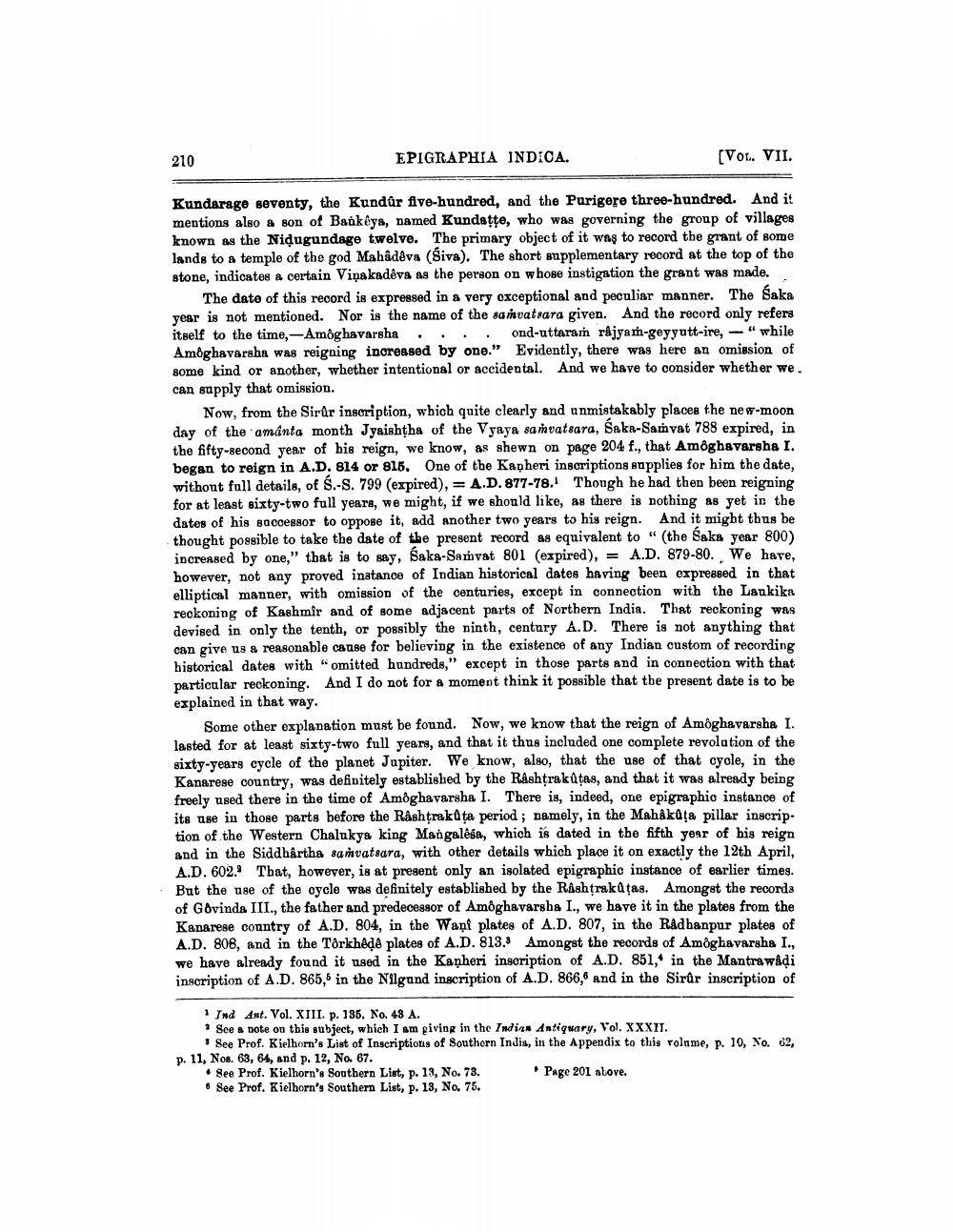________________
210
EPIGRAPHIA INDICA.
(VOL. VII.
Kundarage seventy, the Kundûr five-hundred, and the Purigere three-hundred. And it mentions also a son of Bankėya, named Kundatte, who was governing the gronp of villages known as the Nidugundage twelve. The primary object of it was to record the grant of some lands to a temple of the god Mahadeva (Siva). The short supplementary record at the top of the stone, indicates a certain Viņakadêva as the person on whose instigation the grant was made.
The date of this record is expressed in a very exceptional and peculiar manner. The Saka year is not mentioned. Nor is the name of the samvatsara given. And the record only refers itself to the time,- Amoghavarsha . . . . ond-uttaram rajyam-geyyutt-ire, - " while Amoghavarsha was reigning increased by one." Evidently, there was here an omission of some kind or another, whether intentional or accidental. And we have to consider whether we. can supply that omission.
Now, from the Sirar inscription, which quite clearly and unmistakably places the new-moon day of the amanta month Jyaishtha of the Vyaya samvatsara, Saka-Samvat 788 expired, in the fifty-second year of his reign, we know, as shewn on page 204 f., that Amoghavarsha I. began to reign in A.D. 814 or 815, One of the Kapheri inscriptions supplies for him the date, without full details, of S.-S. 799 (expired), = A.D. 877-78. Though he had then been reigning for at least sixty-two full years, we might, if we should like, as there is nothing as yet in the dates of his successor to oppose it, add another two years to his reign. And it might thus be thought possible to take the date of the present record as equivalent to " (the Saks year 800) increased by one," that is to say, Saka-Samvat 801 (expired), = A.D. 879-80. We have, however, not any proved instance of Indian historical dates having been expressed in that elliptical manner, with omission of the centuries, except in connection with the Lankika reckoning of Kashmir and of some adjacent parts of Northern India. That reckoning was devised in only the tenth, or possibly the ninth, century A.D. There is not anything that can give us a reasonable cause for believing in the existence of any Indian custom of recording historical dates with "omitted hundreds," except in those parts and in connection with that particular reckoning. And I do not for a moment think it possible that the present date is to be explained in that way.
Some other explanation must be found. Now, we know that the reign of Amoghavarsha I. lasted for at least sixty-two full years, and that it thus included one complete revolation of the sixty-years cycle of the planet Jupiter. We know, also, that the use of that cyole, in the Kanarese country, was definitely established by the Rashtrakūtas, and that it was already being freely used there in the time of Amoghavarsha I. There is, indeed, one epigraphic instance of its use in those parts before the Rashtrakūta period ; namely, in the Mahakața pillar inscription of the Western Chalukya king Mangalêsa, which is dated in the fifth year of his reign and in the Siddhartha saívatsara, with other details which place it on exactly the 12th April, A.D. 602. That, however, is at present only an isolated epigraphic instance of earlier times. But the use of the oycle was definitely established by the Rashtrakațas. Amongst the records of Govinda III., the father and predecessor of Amôghavarsha I., we have it in the plates from the Kanarese country of A.D. 804, in the Waņi plates of A.D. 807, in the Radhanpur plates of A.D. 808, and in the Torkhêde plates of A.D. 813. Amongst the records of Amôghavarsha I., we have already found it used in the Kanheri inscription of A.D. 851, in the Mantraw&di inscription of A.D. 865," in the Nilgund inscription of A.D. 866,9 and in the Sirur inscription of
Ind Ant. Vol. XIII. p. 135, No. 48 A. * See a note on this subject, which I am giving in the Indian Antiquary, Vol. XXXIT.
+ See Prof. Kielhorn's List of Inscriptions of Southern Indis, in the Appendix to this rolame, p. 10, No. 02, p. 11, Nos. 63, 64, and p. 12, No. 67. • See Prof. Kielhorn's Southern List, p. 13, No. 73.
Page 201 above. 6 See Prof. Kielhorn's Southern List, p. 13, No. 75.




